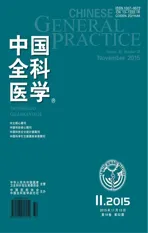心搏骤停后消化系统的损伤及低温治疗对消化系统影响的研究进展
2015-01-25李然马青变
李然,马青变
心搏骤停后消化系统的损伤及低温治疗对消化系统影响的研究进展
李然,马青变
目前,心搏骤停复苏患者自主循环恢复(ROSC)成功率逐渐提高,但患者最终的生存率仍然较低,心搏骤停后综合征(PCAS)或复苏后多脏器功能障碍综合征(MODS)为主要死亡原因。治疗性低温指将患者核心体温降至32~34℃,是目前唯一被证实能够提高心搏骤停患者生存率的方法。低温治疗在神经系统领域应用广泛并且成熟,但目前低温治疗对患者消化系统的受益情况仍存在争议。本文探讨了心搏骤停后消化系统损伤的病理生理机制,总结低温对胃肠道、肝脏及胰腺影响的相关研究,以期为心搏骤停后消化系统损伤的低温治疗提供借鉴。
心脏停搏;消化系统;再灌注损伤;低温;综述
李然,马青变.心搏骤停后消化系统的损伤及低温治疗对消化系统影响的研究进展[J].中国全科医学,2015,18(32):3906-3909.[www.chinagp.net]
Li R,Ma QB.Research progress of the influence of digestive system impairment after cardiac arrest and therapeutic hypothermia on digestive system[J].Chinese General Practice,2015,18(32):3906-3909.
随着现代心肺复苏(CPR)技术和急诊医务人员技术水平的不断提高,心搏骤停复苏患者自主循环恢复(ROSC)成功率也在逐渐提高,可达40%~60%[1]。但患者最终的生存率仍然较低,院内病死率为50%~70%[2-3],心搏骤停后综合征(PCAS)或复苏后多脏器功能障碍综合征(MODS)[4]为主要死亡原因,因此,患者在恢复自主循环后仍面临严峻的临床状况。
治疗性低温指将患者核心体温降至32~34℃,维持12~24 h后复温,是目前唯一被证实能提高心搏骤停患者生存率的方法[5]。其通过降低基础代谢率减少氧耗,减轻系统性炎性反应和超氧化物反应,减少氧自由基的产生和细胞凋亡,改善线粒体功能等,从而达到减轻脏器损伤的目的。低温治疗在神经系统领域应用广泛并且成熟,但目前低温治疗对患者消化系统的受益情况仍存在争议。本文探讨了心搏骤停后消化系统损伤的病理生理机制,总结低温治疗对胃肠道、肝脏及胰腺影响的相关研究,以期为心搏骤停后消化系统损伤的低温治疗提供借鉴。
1 心搏骤停后消化系统损伤的病理生理机制
心搏骤停后消化系统的损伤常累及胃肠道、胰腺、肝脏等重要器官。脏器损伤不仅是由最初长时间全身脏器的缺血引发,再灌注造成的二次损伤同样尤为重要。ROSC后主要表现为心搏骤停后脑损伤、心搏骤停后心肌功能障碍、系统性缺血再灌注反应及持久的病理学状态[4],消化系统损伤的病理生理机制主要为缺血再灌注损伤。患者心搏骤停时,血流和氧输送突然停止,心肺复苏成功后由于心肌抑制,血流动力学不稳定和微血管功能障碍造成血流和组织氧输送不足仍持续存在,导致消化系统的缺血再灌注损伤。有研究显示,ICU心搏骤停后存活患者48 h内胃肠功能紊乱发生率高达60%,其中以腹泻、胃肠营养不耐受常见[6]。心搏骤停4 min可使空肠血流减少持续60 min,肠道内环境乳酸、谷氨酸盐和胆碱水平在缺血再灌注的60~120 min内明显增高。Korth等[7]通过体内微量透析法监测肠缺血发现,心肺复苏后消化道对缺血的敏感程度甚至高于大脑。肠道缺血再灌注会增加肠道屏障的渗透性,从而导致致病菌的移位和内毒素的产生,引起脓毒症和MODS[8-9]。Piton等[10]报道1例心肺复苏后发生急性胰腺炎的患者,但目前尚无大规模的临床研究证实心搏骤停患者复苏后可导致胰腺炎。心搏骤停与肝功能损伤密切相关,心搏骤停后的缺血再灌注损伤可导致肝酶急剧升高[11]。此外,在心肺复苏过程中,会有一定风险发生腹腔脏器损伤,如肝破裂、脾破裂、胃肠道机械性损伤[12]。
2 低温对消化系统的影响
2.1低温对胃肠道的影响目前,低温对于胃肠道影响的研究结果不完全一致。低温使胃排空延迟、肠道蠕动减慢,引起肠梗阻。当体温低于34℃时肠动力减低,降低28℃以下可导致肠梗阻,此时,无论是经口或鼻饲药物的吸收均会受到影响。Reuler[13]研究显示,在低温条件下治疗胃肠道可能会出现点状出血,尸检中发现胃糜烂和黏膜下层出血普遍存在,但未出现明显的临床表现,所以多数浅表性溃疡仅在低温病例尸检中发现,该现象符合急性冷应激反应。Takeuchi等[14]进行的动物实验证实,低温增加胃酸的产生,并减少十二指肠碳酸氢盐的产生,是造成胃和十二指肠黏膜损伤的因素。
相反,有研究证实低温对于腹腔脏器存在有利的影响。Childs等[15]研究显示,低温并不增加坏死性结肠炎的发生风险,且能够减轻缺血再灌注损伤和降低肠道毛细血管通透性。Vollmer等[16]认为,低温能够增加胃黏膜在缺氧条件下的氧合。肠道缺血再灌注损伤引起肠上皮细胞屏障受损,导致细菌的移位和内毒素的产生,低温通过增加低氧诱导因子(HIF-1α)蛋白表达,达到保护心肺复苏后肠缺血再灌注损伤的目的[17-18],并通过降低活性氧水平减轻肠道毛细血管的渗透性。
此外,关于重症患者在低温情况下胃肠营养情况研究较少,有研究对严重脑损伤低温治疗的患者给予营养支持,发现仅19%的患者能够耐受肠内营养[19]。接受低温治疗的心搏骤停患者能够承受相当比例日常营养需求的肠内营养,如有可能,治疗期间给予促胃肠动力药物可能会增加鼻饲喂养的成功率[20]。Thyagarajan等[21]研究显示,低温治疗的围生期缺血缺氧性脑病新生儿,给予少量的肠内营养安全可行。
2.2低温对肝脏的影响低温引起肝功能的损伤,可能源于低温减少心排出量,降低乳酸的清除,从而引起机体酸中毒。肝脏的解毒和合成功能受到抑制,同样影响药物的半衰期。低温情况下,门冬氨酸氨基转移酶、丙氨酸氨基转移酶和胆红素水平随着细胞损伤而升高[22]。然而,也有研究证实,低温能够保护缺血再灌注引起的肝损伤,提高肝血窦灌注和肝窦内皮细胞功能,恢复胆汁的产生[23-26]。低温还能减轻中性粒细胞的募集,恢复肝细胞三磷酸腺苷合成酶活性[27],其机制为减轻促炎递质的产生,减少氧代谢,减轻氧化应激反应,防止钙超负荷引起的线粒体损伤。Han等[28]进行的动物实验结果显示,给予自主循环恢复的猪持续4℃的0.9%氯化钠溶液降温,可维持稳定的血流动力学状态和氧代谢的平衡,且肝酶升高幅度较低,Na+-K+-ATP酶、Ca2+-ATP酶活性升高,肝细胞水肿、炎性反应、线粒体损伤较小。Lee等[29]研究认为,低温能够降低脓毒症大鼠血清肝酶水平,减轻肝组织病理学损伤,降低细胞凋亡标志物Caspase-3的表达。复旦大学附属儿科医院证实,亚低温未加重窒息后缺血缺氧后脑损伤新生儿肝脏功能损伤[30]。
由于病因不同,暴露于低温的时间及程度不同,降温方法(体外降温、血管内降温,局部降温、整体降温)的差异,上述动物实验和临床研究结论有所差异。
2.3低温对胰腺的影响低于治疗性(33.5~34.0℃)水平的意外低温可能导致胰腺炎的发生[22]。低温条件下,胰酶水平轻度升高,有研究者认为其由代谢引起,而非胰腺坏死[31]。Ura等[32]报道1例低温治疗继发胰腺坏死患者,但该患者创伤性脑损伤合并颅内压增高、弥漫性血管内凝血,因此胰腺坏死是否由低温造成不得而知。急性胰腺炎的动物实验显示,亚低温治疗能够减轻系统性炎性反应,减轻胰腺损伤,降低胰酶水平[32-35]。有研究发现,低温情况下可发生胰腺炎,50%的患者仅表现为没有临床症状的血清淀粉酶轻度升高,尸检中发现20%~30%的患者发生胰腺炎[36-37]。低温导致胰腺炎的原因尚有争议,其可能的原因为微循环血栓形成引起胰腺缺血和坏死。动物研究显示,冷却胰腺数小时后,其外分泌功能受损,血清淀粉酶水平升高[38]。另有研究发现,接受低温治疗的患者出现血糖升高,尚不清楚其原因为胰岛素抵抗还是胰腺内分泌功能降低。对于重症患者,高血糖与高患病率、病死率存在高度相关,因此,低温治疗患者严格控制血糖至关重要。
综上所述,低温治疗在临床多个领域被证实具有减轻脏器损伤的作用,但其对消化系统影响的病理生理机制复杂,研究结论不一,能否减轻心搏骤停患者的消化系统损伤尚存在诸多争议,还需大量基础实验和临床研究进一步探索。
[1]Thel MC,O'connor CM.Cardiopulmonary resuscitation:historical perspective to recent investigations[J].Am Heart J,1999,137 (1):39-48.
[2]Nadkarni VM,Larkin GL,Peberdy MA,et al.First documented rhythm and clinical outcome from in-hospital cardiac arrest among children and adults[J].JAMA,2006,295(1):50-57.
[3]Nolan JP,Laver SR,Welch CA,etal.Outcome following admission to UK intensive care units after cardiac arrest:a secondary analysis of the ICNARC Case Mix Programme Database[J].Anaesthesia,2007,62(12):1207-1216.
[4]Neumar RW,Nolan JP,Adrie C,et al.Post-cardiac arrest syndrome:epidemiology,pathophysiology,treatment,and prognostication.A consensus statement from the International Liaison Committee on Resuscitation(American Heart Association,Australian and New Zealand Council on Resuscitation,European Resuscitation Council,Heart and Stroke Foundation of Canada,InterAmerican Heart Foundation,Resuscitation Council of Asia,and the Resuscitation Council of Southern Africa);the American Heart Association Emergency Cardiovascular Care Committee;the Council on Cardiovascular Surgery and Anesthesia;the Council on Cardiopulmonary,Perioperative,and Critical Care;the Council on Clinical Cardiology;and the Stroke Council[J].Circulation,2008,118(23):2452-2483.
[5]Reynolds JC,Lawner BJ.Management of the post-cardiac arrest syndrome[J].JEmerg Med,2012,42(4):440-449.
[6]Gaussorgues P,Gueugniaud PY,Vedrinne JM,et al.Bacteremia following cardiac arrest and cardiopulmonary resuscitation[J].Intensive Care Med,1988,14(5):575-577.
[7]Korth U,Krieter H,Denz C,et al.Intestinal ischaemia during cardiac arrest and resuscitation:comparative analysis of extracellular metabolites by microdialysis[J].Resuscitation,2003,58(2): 209-217.
[8]Pan H,Chen D,Liu B,et al.Effects of Sodium hydrosulfide on intestinal mucosal injury in a rat model of cardiac arrest and cardiopulmonary resuscitation[J].Life Sci,2013,93 (1):24-29.
[9]L'Her E,Cassaz C,Le Gal G,et al.Gut dysfunction and endoscopic lesions after out-of-hospital cardiac arrest[J].Resuscitation,2005,66(3):331-334.
[10]Piton G,Barbot O,Manzon C,et al.Acute ischemic pancreatitis following cardiac arrest:a case report[J].JOP,2010,11(5): 456-459.
[11]Levesque E,Hoti E,Khalfallah M,et al.Impact of reversible cardiac arrest in the brain-dead organ donor on the outcome of adult liver transplantation[J].Liver Transpl,2011,17(10):1159-1166.
[12]Meron G,Kurkciyan I,Sterz F,et al.Cardiopulmonary resuscitation-associated major liver injury[J].Resuscitation,2007,75(3):445-453.
[13]Reuler JB.Hypothermia:pathophysiology,clinical settings,and management[J].Ann Intern Med,1978,89(4):519-527.
[14]Takeuchi K,Suzuki K,Araki H,et al.Roles of endogenous prostaglandins and nitric oxide in gastroduodenal ulcerogenic responses induced in rats by hypothermic stress[J].J Physiol Paris,1999,93(5):423-431.
[15]Childs EW,Udobi KF,Hunter FA.Hypothermia reduces microvascular permeability and reactive oxygen species expression after hemorrhagic shock[J].J Trauma,2005,58(2):271-277.
[16]Vollmer C,Wei S,Beck C,et al.Hypothermia improves oral and gastric mucosal oxygenation during hypoxic challenges[J].Br J Anaesth,2014,113(3):433-442.
[17]Albrecht M,Gruenewald M,Zitta K,et al.Hypothermia and anesthetic postconditioning influence the expression and activity of small intestinal proteins possibly involved in ischemia/reperfusionmediated events following cardiopulmonary resuscitation[J].Resuscitation,2012,83(1):113-118.
[18]Kimura Y,Pierro A,Eaton S. Glutathione synthesis in intestinalischaemia - reperfusion injury: effects of moderate hypothermia [J].J Pediatr Surg,2009,44 (2) : 353 - 357.
[19]Stefanutti G,Pierro A,Vinardi S,et al.Moderate hypothermia protects against systemic oxidative stress in a ratmodel of intestinal ischemia and reperfusion injury[J].Shock,2005,24(2):159-164.
[20]Williams ML,Nolan JP.Is enteral feeding tolerated during therapeutic hypothermia?[J].Resuscitation,2014,85(11): 1469-1472.
[21]Thyagarajan B,Tillqvist E,Baral V,et al.Minimal enteral nutrition during neonatal hypothermia treatment for perinatal hypoxic-ischaemic encephalopathy is safe and feasible[J].Acta Paediatr,2015,104(2):146-151.
[22]Mallet ML.Pathophysiology of accidental hypothermia[J].QJM,2002,95(12):775-785.
[23]Niemann CU,Choi S,Behrends M,et al.Mild hypothermia protects obese rats from fulminant hepatic necrosis induced by ischemia-reperfusion[J].Surgery,2006,140(3):404-412.
[24]Kuboki S,Okaya T,Schuster R,et al.Hepatocyte NF-kappaB activation is hepatoprotective during ischemia-reperfusion injury and is augmented by ischemic hypothermia[J].Am J Physiol Gastrointest Liver Physiol,2007,292(1):G201-207.
[25]Heijnen BH,Straatsburg IH,Gouma DJ,et al.Decrease in core liver temperature with 10 degrees C by in situ hypothermic perfusionunder total hepatic vascular exclusion reduces liver ischemia and reperfusion injury during partial hepatectomy in pigs[J].Surgery,2003,134(5):806-817.
[26]Choi S,Noh J,Hirose R,et al.Mild hypothermia provides significant protection against ischemia/reperfusion injury in livers of obese and lean rats[J].Ann Surg,2005,241(3):470-476.
[27]Stefanutti G,Pierro A,Parkinson EJ,et al.Moderate hypothermia as a rescue therapy against intestinal ischemia and reperfusion injury in the rat[J].Crit Care Med,2008,36(5):1564-1572.
[28]Han Y,Song ZJ,Tong CY,et al.Effects of hypothermia on the liver in a swinemodel of cardiopulmonary resuscitation[J].World J Emerg Med,2013,4(4):298-303.
[29]Lee JH,Kim K,Jo YH,et al.Therapeutic hypothermia attenuates liver injury in polymicrobial sepsis model of rats via Akt survival pathway[J].JSurg Res,2013,181(1):114-120.
[30]Zhang XD,Zhou WH,Shao XM,et al.Effects of hypothermia on digestive system function in neonates after birth asphyxia[J].Journal of Applied Clinical Pediatrics,2003,3(3):172-173.(in Chinese)张旭东,周文浩,邵肖梅,等.亚低温治疗对窒息新生儿消化系统功能的影响[J].实用儿科临床杂志,2003,3(3):172-173.
[31]Polderman KH.Mechanisms of action,physiological effects,and complications of hypothermia[J].Crit Care Med,2009,37(7 Suppl):S186-202.
[32]Ura H,Asai Y,Mori K,et al.Total necrosis of the pancreas and renal cortex secondary to hypothermia therapy[J].J Trauma,2002,52(5):987-989.
[33]Wang X,Jiang W,Zhao G,et al.Mild hypothermia protects against Sodium taurocholate(Na Tc)-induced acute pancreatitis in rats with adverse effects on serum cytokines[J].Pancreas,2005,30(4):e80-86.
[34]Matsuoka K,Ueno T,Morita K,et al.Effects of moderate hypothermia on proinflammatory cytokine production in a ratmodel of caerulein-induced pancreatitis[J].Pancreas,2003,26(1): e12-17.
[35]Fujimoto K,Fujita M,Tsuruta R,et al.Early induction of moderate hypothermia suppresses systemic inflammatory cytokines and intracellular adhesion molecule-1 in rats with caeruleininduced pancreatitis and endotoxemia[J].Pancreas,2008,37 (2):176-181.
[36]Foulis AK.Morphological study of the relation between accidental hypothermia and acute pancreatitis[J].JClin Pathol,1982,35 (11):1244-1248.
[37]Maclean D,Murison J,Griffiths PD.Acute pancreatitis and diabetic ketoacidosis in accidental hypothermia and hypothermic myxoedema[J].Br Med J,1973,4(5895):757-761.
[38]Hirano T,Manabe T,Imanishi K,et al.Direct surface cooling of the exocrine pancreas in the rat[J].Br J Surg,1992,79(8): 803-806.
(本文编辑:吴立波)
Research Progress of the Influence of Digestive System Im pairm ent After Cardiac Arrest and Therapeutic Hypotherm ia on Digestive System
LIRan,MAQing-bian.Department of Emergency,Peking University Third Hospital,Beijing 100191,China
At present,the success rate of return of spontaneous circulation(ROSC)in patientswith cardiac arrest has gradually improved,but the final survival rate of patients is still low.Post-cardiac arrest syndrome(PCAS)andmultiple organ dysfunction syndrome(MODS)are the major causes of death.Therapeutic hypothermia is defined as patient's core body temperature being down to 32 to 34℃,and it has been proven the only way to improve the survival rate of patients with cardiac arrest so far.Hypothermia has been widely used and has become mature in the field of nervous system,but the influence of hypothermia on the digestive system remains controversial.This paper discussed the pathophysiologicalmechanism of the digestive system injury following cardiac arrest,andmade a review of the related research of the influence of hypothermia on gastrointestinal tract,liver and pancreas in order to provide references for hypothermia treatment after cardiac arrest.
Heart arrest;Digestive system;Reperfusion injury;Hypothermia;Review
R 541.78
A
10.3969/j.issn.1007-9572.2015.32.003
北京市科委科技计划项目(Z1311070022131142);北京大学第三医院临床重点项目(BYSY201208)
100191北京市,北京大学第三医院急诊科
马青变,100191北京市,北京大学第三医院急诊科; E-mail:maqingbian@medmail.com.cn
2015-05-28;
2015-09-20)
